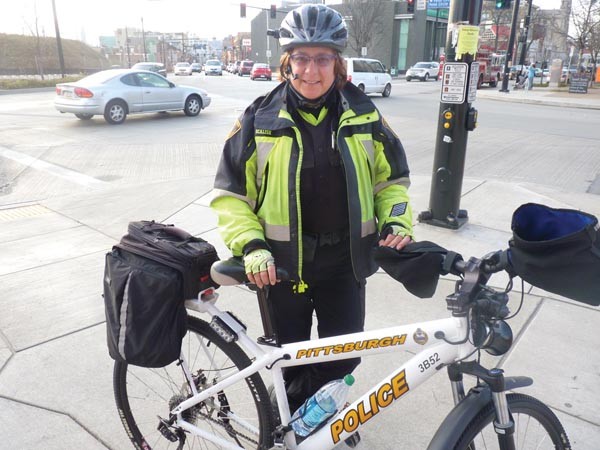Christine Scalise might be one of the most noticeable cyclists on the road. A bike officer for the past 13 years, she has never been in a wreck with a vehicle.
She admits that she's pretty easy to notice — "the uniform is highly visible and we're carrying a gun," she says. But despite her occupation, as a cyclist, she still hesitates when she's on the road.
"There are certain roadways I avoid because of the congestion and I wouldn't feel comfortable riding," Scalise says.
The past year has been one of the most dangerous on record for cyclists locally, and the job of dealing with the numerous accidents, attacks and incidents falls to Pittsburgh police and officers like Scalise.
Tensions can be high between cyclists and motorists — something officers know all too well. Police commander Scott Schubert, for example, says he doesn't have to go far to get a sense of how motorists and bicyclists feel about each other.
"All you have to do is look at the paper after a crash and read the comments," he says. "There's definitely a bicycle side, where they're saying ‘We have just as much right as you' and then you have some of the motorists respond, saying ‘Wait a minute, you have the same responsibility on the road.'"
Schubert and Scalise say that the anger and disdain often displayed online isn't something that manifests wholly on the streets, if at all. But they do say road rage between many people on the road, regardless of their mode, is alive and well.
"One side is always pointing the finger at the other," says Schubert. "We've got to get past that and do what is safe. When you have motorists who are violating laws, they need to be held accountable, and when you have bicyclists who go through red lights, stop signs, etc., they need to be held accountable."
That's partly where Scalise and other bike officers come in. She has been an officer for the city since 1994 and, in 1999, joined the bike division — which has 17 officers around the city who patrol year-round. Scalise trained in a 40-hour class through the International Police Mountain Biking Association, and takes courses annually.
Working out of Zone 5, in Highland Park, Scalise primarily patrols Penn Circle and part of East Liberty. With a patrol speed of 10 to 12 miles per hour, "that affords us the ability to see what's going on" and interact more with the community.
Her bike is outfitted with a siren, air horns and LED lights. She carries handcuffs, a baton, a weapon and everything every other police officer carries. And yes, she's pulled vehicles over on her bicycle.
"I haven't had a problem with motorists too much in 13 years," she says. "I can't think of any examples of disrespect. I have had people challenge me to race, though."
She acknowledges that she's been fortunate not to have been in an accident with another vehicle.
"It's possible we command more respect on the road, but at the same time we're held to a higher level ... because we're cyclists," she says. That's not to say she's been accident-free. She has wrecked her bike while policing — once chasing after a culprit in a torn-up parking lot, and another time while following a bike thief down a flight of stairs.
When operating on the road, police say, cyclists are supposed to abide by the laws of traffic: stop at red lights and stop signs, and indicate which way they are turning. Between sundown and sunrise, they are required to have headlamps and reflectors. Cyclists aren't allowed to ride on the sidewalks of business districts.
Drivers "need to be aware that I'm supposed to be on the road. I'm not supposed to be on the sidewalk," she says. "A lot of car drivers are very territorial."
And when it comes to riding safely, "A lot of the onus is put on the cyclist but a fair amount of responsibility needs to be placed on the vehicle driver," she says. "They're the ones with a thousand-pound machine under them."
Scalise does her best to educate drivers, warning them or pulling them over if she sees a traffic violation. She carries stickers that remind them about the recently passed state law requiring motorists to give cyclists at least four feet clearance when passing, as well as stickers reminding cyclists to wear their helmets.
But cyclists have to balance their safety with their rights, making sure they are seen and are behaving predictably so drivers know what they are doing.
"On one hand, you've got to yield to the bigger thing, but [you] also have to stake your claim," she says. "It's a fine balance."


